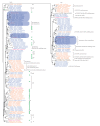Archaeal ubiquitin-like proteins: functional versatility and putative ancestral involvement in tRNA modification revealed by comparative genomic analysis
- PMID: 20936112
- PMCID: PMC2948915
- DOI: 10.1155/2010/710303
Archaeal ubiquitin-like proteins: functional versatility and putative ancestral involvement in tRNA modification revealed by comparative genomic analysis
Abstract
The recent discovery of protein modification by SAMPs, ubiquitin-like (Ubl) proteins from the archaeon Haloferax volcanii, prompted a comprehensive comparative-genomic analysis of archaeal Ubl protein genes and the genes for enzymes thought to be functionally associated with Ubl proteins. This analysis showed that most archaea encode members of two major groups of Ubl proteins with the β-grasp fold, the ThiS and MoaD families, and indicated that the ThiS family genes are rarely linked to genes for thiamine or Mo/W cofactor metabolism enzymes but instead are most often associated with genes for enzymes of tRNA modification. Therefore it is hypothesized that the ancestral function of the archaeal Ubl proteins is sulfur insertion into modified nucleotides in tRNAs, an activity analogous to that of the URM1 protein in eukaryotes. Together with additional, previously described genomic associations, these findings indicate that systems for protein quality control operating at different levels, including tRNA modification that controls translation fidelity, protein ubiquitination that regulates protein degradation, and, possibly, mRNA degradation by the exosome, are functionally and evolutionarily linked.
Figures
References
-
- Kerscher O, Felberbaum R, Hochstrasser M. Modification of proteins by ubiquitin and ubiquitin-like proteins. Annual Review of Cell and Developmental Biology. 2006;22:159–180. - PubMed
-
- Weissman AM. Themes and variations on ubiquitylation. Nature Reviews Molecular Cell Biology. 2001;2(3):169–178. - PubMed
-
- Iyer LM, Koonin EV, Aravind L. Novel predicted peptidases with a potential role in the ubiquitin signaling pathway. Cell Cycle. 2004;3(11):1440–1450. - PubMed
Publication types
MeSH terms
Substances
Grants and funding
LinkOut - more resources
Full Text Sources
Molecular Biology Databases


